
Flies
The INSPECTION process begins with a customer interview, followed by a thorough visual inspection for pest IDENTIFICATION and DETERMINATION of a course of action.
- Structural cracks & crevices that can hold moisture/organic debris or allow pest entry into the structure
- The condition of the dumpster and/or its proximity to the structure
- Conditions conducive to fly breeding, such as the presence of garbage, animal feces and/or organic build-up
- Outdoor cooking and/or dining activities
- Loading docks/receiving areas
- Mechanical fly exclusion, such as condition of door seals, condition of windows & screens, and/or the presence of/need for air curtains
- Grease trap condition, roof top grease and/or debris accumulation
- Adjacent businesses (such as a landfill) and how they might contribute to this site’s fly population
- Overall exterior sanitation
- Organic debris that can be found in floor level cracks & crevices, such as baseboards and grout joints, under cook lines, in/around legs, feet and wheels of prep tables, sink tables and similar units, the grease trap, and in storage areas
- Moisture sources, such as sinks, ice machines, utility closets, water heater closets and floor drains, as well as above-ground pipes and/or hoses that empty into floor drains
The pest professional makes thorough notes of all findings, take photos as appropriate, and always invites the customer to participate in the inspection process. He then develops a graph and site plan, and takes relevant photos to document his findings.
Fleas
Fleas in the workplace?
It doesn’t need to be a pet store, kennel, or veterinarian’s office to have a flea problem. Fleas can be introduced into the office by a domesticated dog or cat coming in with an employee or customer. The animal doesn’t need to stay, even a brief visit can bring fleas into the business.
There are more than 2,000 species of fleas, but the most common is the cat flea. It feeds on mammals, including dogs, cats, and humans. Unlike most other flea species, the adult cat flea stays on its host and can take up to twenty blood meals each day. This flea is a potential vector of diseases, such as the plague, Murine typhus, tularemia and dog tapeworm.
When a flea bites a human, a small red spot with a single puncture point develops. Generally, the flea takes its blood meal around the ankles of its human host. Bites may itch, but swelling is unusual. Keep in mind that ants and spiders leave two puncture marks and the bite of a mosquito or sting of a bee generally results in some swelling at the site.
Inspection
It begins with a customer interview, followed by a thorough visual inspection for pest IDENTIFICATION and DETERMINATION of a course of action.
Fleas are attracted to the color white. Once you’ve identified the “hot zone,” place a piece of white paper on the floor and wait a few minutes. Fleas will generally collect on the paper. They look like small black dots. Now, you’ve confirmed their presence!
It’s critical for the pest professional to interview the customer. Frequently, what generates the call for help is an employee and/or the business’s clients complaining about insect bites. The pest professional asks the customer about the presence of pets in his business, whether routine or occasional. He conducts a visual inspection of the area(s) where employees report getting bit and/or where pets are or were present. Any surface is susceptible to infestation, including carpeting, upholstery, offices, waiting areas, etc.
The pest professional makes thorough notes of all findings and always invites the customer to participate in the inspection process. He then develops a graph and site plan that outlines his findings.
The pest professional discusses with the customer which areas require preparation before treatment.
